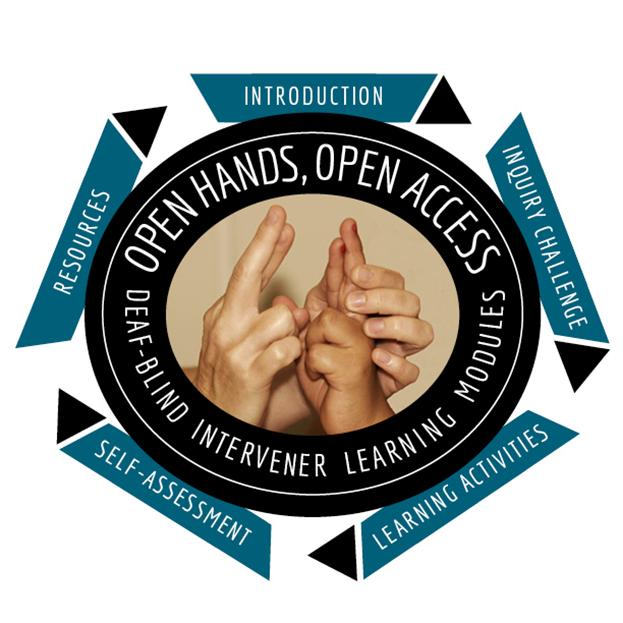
Practical tips for teaching students with deaf-blindness (accessibility)
A person who has deaf-blindness has a greater or lesser extent of hearing and vision loss. This results in difficulties accessing information.
Persons with deaf-blindness use different communication methods. Persons with deaf blindness may be accompanied by an intervenor, a professional who is trained in tactile sign language. This sign language involves touching the hands of the client using a two handed, manual alphabet, also known as finger spelling.
More Details : Download (pdf, 110kb)
Communication Strategies for Persons with Deafblindness
Forms to Send Messages
- Talking
- Sign language
- Eye contact
- Facial expressions
- Body gestures
- Written text
- Change in muscle tension (pain-tighten up, happy-relaxed muscles)
- Augmentative communication devices (voice-output device, picture cards)
More Details : Download (pdf, 2mb)
Deafblindness overview
- Concept and Meaning of Deafblindness
- Historical Perspective
- Causes of Deafblindness
- Incidence and Magnitude of Deafblindness
- Manpower Development
- Role of the Government Organizations and NGOs
More Details : Download (pdf, 184 kB)
Handbook for Teachers Serving Students who are Deafblind, Deaf or Hard of Hearing with Additional Disabilities, and Blind or Visually Impaired with Additional Disabilities
Individuals are considered to be deafblind if they have a substantial loss of both sight and hearing such that neither is a reliable access to information.
The combination of these sensory losses results in significant difficulties in acquiring educational, vocational, avocational and social skills.
More Details : Download (pdf, 219 kB)
Deafblindness: Educational Service Guidelines
- Educators should be knowledgeable about the diversity of students who are deafblind and their unique educational needs.
- Educators should have the knowledge and skills to meet the unique educational needs of students who are deafblind, including those with additional disabilities.
More Details : Download (pdf, 638 kB)
Education of Children with Deafblindness and Additional Disabilities
A person is deafblind when he or she has a severe degree of combined visual and auditory impairment. Some deafblind people are totally deaf and blind, while others have residual hewing and vision.
The severity of the combined visual and auditory impairments results in severe learning and communication problems
More Details : Download (pdf, 6 MB)
Children with Deaf-Blindness: A Parent Mini-Guide
As the parent of a child with deaf-blindness, you face many challenges every day. You have hopes and dreams for your child, and you want their educational services to help them develop and learn.
More Details : Download (pdf, 228 kB)
Learning Styles in Deafblind children : Perspectives from practice (Thesis)
Many children with undamaged brains were shuffled in among the retarded because they were unable to tell anyone that they were in there behind their sightless eyes.
They failed the batteries of tactile tests, unaware that their fates hung in the balance when they were asked to fit round pegs into round holes to the ticking of a clock they could not see or hear. As a result they spent the rest of their lives in bed, and none of them complained, either.
More Details : Download (pdf, 4 MB)
Interveners for Students with Deafblindness
- The Unique Educational Needs of Children With Deafblindness (Assessment, Unique Instructional Needs and Strategies)
- Travel and Exploration of the Environment (Adaptive and Assistive Devices, Access to Information, communication )
- Behavior (Additional Disabilities, Consistency and Routine, Roles in the Educational Team, Professional Expertise)
- How Interveners Differ From Other Typical Support Staff
More Details : Download (pdf, 185 kB)
Training Module on Deafblindness
Deafblindness is a low incidence disability and is hidden in community. There is no data available regarding the size of the deafblind population in India as, to date there has been no comprehensive study or research to determine the true incidence.
Estimates, based on information gathered from community based projects, indicate that there could be more than 450,000 deafblind/ multiple disabled people in the country.
Introduction to Deafblindness
Educational Aspects
Orientation and Mobility
More Details : Download (pdf, 225 kB)
Strategies for Inclusion of Children with Multiple Disabilities, including Deaf-Blindness
- Awareness of the learning challenges related to combined vision and hearing loss
- Awareness of strategies that facilitate inclusion and emergent literacy based on defining features of access,
- participation and supports
- Awareness of resources available related to supporting children with deaf-blindness
More Details : Download (pdf, 3 MB)